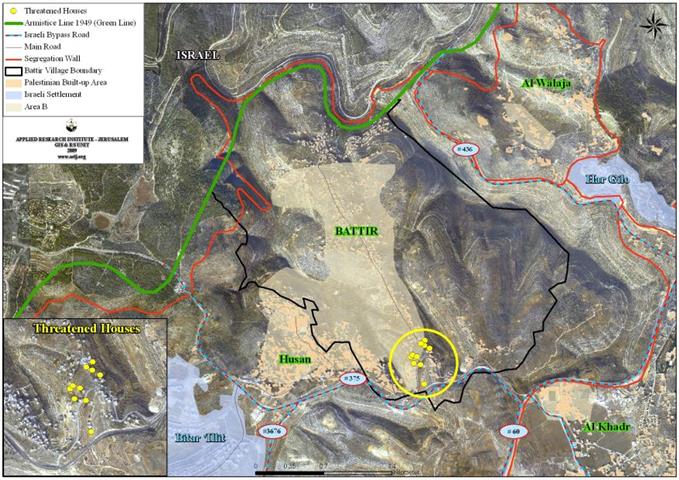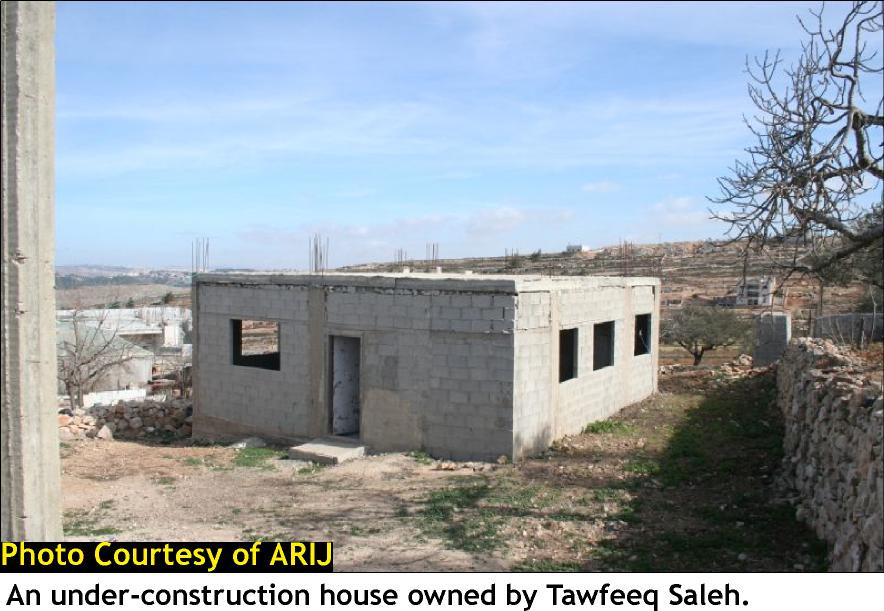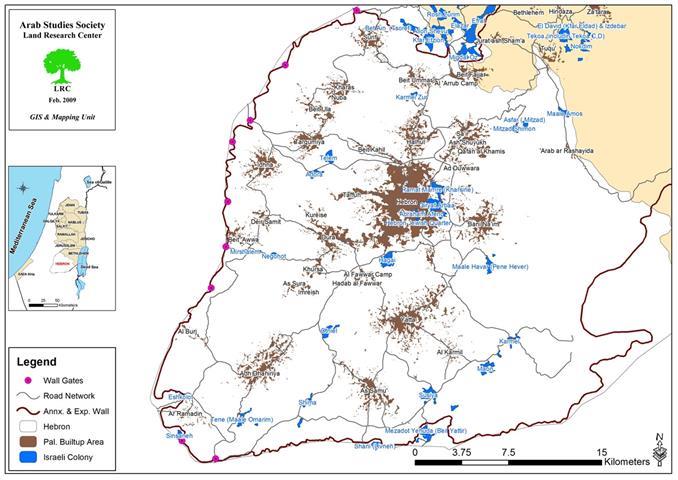On January 20, 2009, the Israeli Occupation Army handed ten Palestinian local residents from Battier village west of Bethlehem Governorate demolition orders to their houses under the pretext of lacking building permits. In a field work conducted by the Applied Research Institute Jerusalem � ARIJ, ten families received eight demolition orders to their house in addition to another two demolition orders for a Gas Station and a horse stable. See Table 1 & map below
|
The threatened Palestinian Houses in Battier Village |
||||
|
No. |
Owner |
Description |
Area/m2 |
Status |
|
1 |
Two floors and basement |
1000 |
Under construction |
|
|
2 |
Three floors and basement |
1000 |
Populated |
|
|
3 |
Mohammad Isma'il Hamamreh |
Two floors and basement |
500 |
Under construction |
|
4 |
Gas Station |
350 |
Working |
|
|
5 |
Mohammad Hilmi Jaber |
Horse Stable |
30 |
Under construction |
|
6 |
One floor and basement |
400 |
Populated |
|
|
7 |
Two floors |
180 |
Under construction |
|
|
8 |
Three floors and basemen |
100 |
Under construction |
|
|
9 |
Tawfiq Saleh |
Two Houses |
280 |
Under construction |
|
10 |
One floor and basement |
260 |
Under construction |
|
Battier is one of the western rural villages of Bethlehem Governorate, located approximately 2 kilometers away from the Green Line (Armistice Line 1949). The village residents are 4911 (PCBS 2008), and spread on an area of 7164 dunums from which 291 dunums (4% from the total village area) constitutes the built-up area of the village.
According to Oslo Agreement of 1995, which signed between the PLO (Palestinian Liberation Organization) and Israel, 2012 dunums (28.1% from the village total area) from Battier village lands classified as Area B where the Palestinian Authority has the responsible of the civil and administrative issues, while Israel is responsible maintain control over security.The remaining area of Battier, 5152 dunums (71.9 % from the total village area) went under area C classification where Israel enjoys absolute control.
Long track of Israeli violations record in Battier Village
Battier, next to dozens of the Palestinian villages and communities in the occupied West Bank territory had been subjected to many Israeli colonial practices to serve the interest of the Israeli occupation. From land confiscation to build settlements, bypass roads, outposts to the Apartheid plans where of the Israeli Segregation Wall that surrounded many Palestinian villages in Bethlehem Governorate within enclaves, Battier was one of the western rural villages and hamlets (Hussan Al Walajeh, Nahalin, Wadi Fukin, Al Jaba'a, Khalet 'Affaneh, Khalet Al-Balluta and Khalet Beit Zakaria), which are collectively cut and isolated from the center of the main cities in Bethlehem Governorate, which mean that the residents of these villages and communities will have a hard time accessing areas where main services are available.
Since the Israeli Army started with the construction of the Israeli Segregation Wall, Battier village had received four military orders to confiscate hundreds of dunums from the village's lands mainly to build the Israeli Apartheid Segregation Wall, and consequently isolate much more of the village land behind it. The military orders were as follows:
-
On April 24, 2004, Battier village was partially included within a military order served to nearby village of Hussan. The Israeli military order holding number (31/04/T) confiscated 4.6 dunums from Battier village lands to build the Segregation Wall.
-
On May 1, 2005, the villages of Battier, Hussan, Wadi Fukin and Al Walajeh, had received an Israeli military order holding number (86/05/T) to confiscate 766.6 dunums from the villages lands to build the Segregation Wall there.
-
On October 21, 2005, the villages of Battier, Al Khader and Beit Jala city had received an Israeli military order holding number (210/05/T) to confiscate 85 dunums from their lands to build Al Khader Terminal passage.
-
On February 7, 2007, Battier village received a new Israeli military order holding number (69/06) to confiscate 22 dunums from the village lands to complete the section of the Israeli Apartheid Segregation Wall enclosing the village.
Legal & International Status
Israel is acting on the ground to apply a long-term plan to strangulate the Palestinian villages and communities and to interrupt their geographical contiguity in order to cut them from each other, to prevent the Palestinian people from living and building on their own lands, and eventually to squeeze them out of their villages into the main cities.
The Israeli demolition of the Palestinian houses is a grave breach of many of the International Agreements and Conventions such as:
-
Article 53 of the Fourth Geneva Convention provides that 'any destruction by the Occupying power of real or personal property belonging individually or collectively to private persons, or to the State, or other public authorities or social or cooperative organizations is prohibited, except where such destruction is rendered absolutely necessary by military operations.'
-
Article 147 of the Fourth Geneva Conventionalso indicated that: Extensive destruction and appropriation of property not justified by military necessity and carried out unlawfully and wantonly. is a grave breach of the Convention.
-
Moreover, Art. 23 of the Hague Convention of 1907 also provides: In addition to the prohibitions provided by special Conventions, it is especially forbidden to destroy or seize the enemy's property, unless such destruction or seizure be imperatively demanded by the necessities of war.
-
And Under the Universal Declaration of Human Rights adopted and proclaimed by General Assembly resolution 217 A (III) of, December 10, 1948, Article 17 reads: 'No one shall be arbitrarily deprived of his property.' Which means it bans Israel from destroying or confiscating the property of the Palestinians at any case.
Prepared by:
The Applied Research Institute – Jerusalem

















